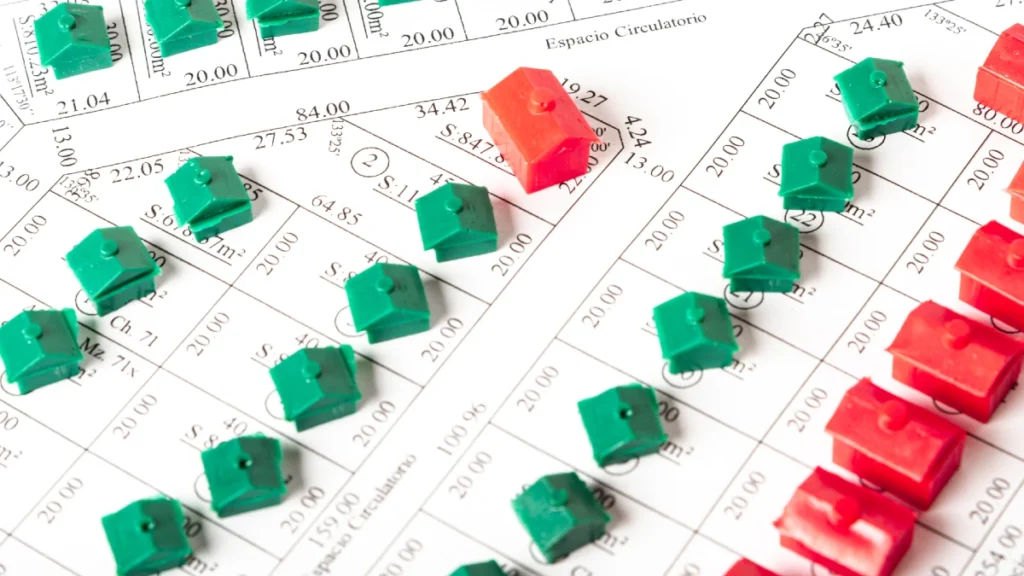In 2025, America’s housing market reveals a stark reality: only about one in eight renters can afford a median-priced home.
This troubling statistic, shared by Harvard’s Joint Center for Housing Studies, reflects millions of Americans watching homeownership become an increasingly distant dream with each passing year.
The gap between incomes and rising housing costs has created an affordability crisis of historic proportions. Millions of Americans remain trapped in the cycle of renting, with homeownership slipping further out of reach. As median home prices climb to new heights in 2025, financial requirements for homeownership become more prohibitive.
For many renters, monthly payments consume so much of their income that saving for a down payment seems nearly impossible. This creates a self-perpetuating cycle, where renters struggle to break free.
In this guide, we provide actionable strategies to navigate the housing market and offer potential paths out of the renters’ trap.
The housing affordability crisis is felt nationwide, but its effects differ by location, income, and individual circumstances. By understanding the factors driving the homeownership gap, renters can make informed decisions.
Exploring alternative pathways to housing wealth can help achieve long-term stability in an increasingly challenging market.
| Key Metric | Value | Context |
|---|---|---|
| Median Home Price | $412,500 | Up 60% nationwide since 2019 |
| Monthly Mortgage Payment | $2,570 | Based on 30-year loan with 3.5% down payment |
| Income Needed for Median Home | $126,700+ | To afford mortgage, taxes, and insurance |
| Renters Who Can Afford Median Home | 1 in 8 | Only 6 million of 46 million renters qualify |
| Households Unable to Afford $300K Home | 57% | 76.4 million of 134.3 million U.S. households |
| Median-to-Income Ratio | 5:1 | Far above the 3:1 traditional affordability standard |
| Cost-Burdened Renters | 50% | 22.6 million renters spending >30% of income on housing |
The 2025 Housing Market: By the Numbers

The numbers tell a troubling story about housing affordability in America today. According to the latest data from the Harvard Joint Center for Housing Studies, the median existing single-family home price hit $412,500 in 2024, with continued growth pushing prices even higher in 2025.
This represents a shocking five times the median household income—far above the price-to-income ratio of 3 that has traditionally been considered affordable.
This price surge has created daunting financial barriers for aspiring homeowners. With current mortgage rates hovering around 6.5-7%, monthly payments on the median-priced home have risen to $2,570 under terms typical for first-time homebuyers (30-year loan with a 3.5 percent down payment).
To afford these payments plus associated taxes and insurance costs, a household would need an annual income of at least $126,700—a threshold that only about 6 million of the nation’s nearly 46 million renters can meet. This translates to roughly one in eight renters having sufficient income to afford a median-priced home.
The affordability crisis extends beyond just median-priced homes. According to the National Association of Home Builders (NAHB), 57% of U.S. households (76.4 million out of 134.3 million) cannot afford even a $300,000 home based on conventional underwriting standards.
For newly constructed homes, the situation is even more dire, with a median price of $459,826 in 2025, placing new construction out of reach for roughly 75% of American households.
Regional variations add another layer of complexity to the housing affordability picture. The Northeast has experienced the most significant price growth, with home values rising by 6.8% on average in early 2025, followed by the Midwest (5.2%), West (2.4%), and South (1.8%), according to Freddie Mac House Price Index data.
Despite slower growth in the South and West, these regions still face severe affordability challenges due to years of accumulated price increases. In high-cost coastal markets like Los Angeles, the situation has become so extreme that typical annual housing costs now exceed typical annual income.
Historically, these conditions represent a dramatic departure from housing norms. Home prices have risen 60% nationwide since 2019, significantly outpacing historical appreciation rates of around 4% annually.
According to Zillow research, the past five years have effectively compressed more than a decade of typical home price appreciation into half that time, fundamentally altering the relationship between income and housing costs for millions of Americans.
Five Forces Driving the Homeownership Affordability Gap

The growing divide between renting and owning isn’t happening by chance. Five powerful economic forces have converged to create today’s unprecedented affordability challenges, transforming homeownership from an achievable milestone into an increasingly exclusive privilege.
1. Persistently high mortgage rates have dramatically increased the cost of financing a home purchase. With rates hovering between 6.5-7% in 2025—more than double the 2.99% available in June 2021—the monthly payment required for the same home has increased by hundreds of dollars.
According to Mortgage Reports, this rate increase has added around $580 to the monthly cost of a $300,000 mortgage, effectively pricing out millions of potential buyers who would have qualified just a few years ago. While rates have stabilized, they remain well above the sub-3% levels that fueled the market during the pandemic era.
2. Housing prices continue to outpace wage growth at an alarming rate. While median wages have increased approximately 32% from 2019 to 2025 according to the Atlanta Federal Reserve Wage Growth Tracker, home values have surged by over 45% during the same period.
This widening gap has pushed the price-to-income ratio to 5:1 in 2024-2025, far exceeding the traditional 3:1 affordability standard. Nick Gerli, CEO of Reventure App, estimates that the current average monthly mortgage payment of around $2,800 would need to drop to $2,100 to align with the estimated U.S. median income for 2025 of approximately $84,000.
3. The rising cost of homeownership extends beyond mortgage payments. Insurance premiums have jumped 57% from 2019 to 2024, with the sharpest increases in areas with the greatest risk of climate-related disasters. In Miami, for example, a median-priced home now comes with an annual insurance payment exceeding $11,000.
Property taxes have also increased significantly, rising by an average of 12% between 2021 and 2023, with some states like Wyoming seeing increases of up to 37%. These ancillary costs add thousands of dollars to annual housing expenses, further eroding affordability.
4. A critical shortage of housing inventory, particularly for starter homes, continues to plague the market. The construction of smaller homes (under 1,800 square feet with three or fewer bedrooms) has declined for decades as builders have focused on larger, more profitable properties.
Harvard researchers estimate that had household formation rates continued at pre-pandemic levels, two million more households would have formed for the same population—pointing to a significant unmet housing need. While multifamily construction has increased, with 608,000 new rental units completed in 2024 (the most in nearly four decades), much of this new supply targets the upper end of the market rather than addressing affordable housing needs.
5. Persistent inflation has eroded savings potential for prospective homebuyers. While general inflation has moderated from its 2022 peaks, shelter costs continue to rise at rates well above 5%, accounting for more than half of overall inflation in the economy according to NAHB.
The combination of high rents and elevated costs for essentials like food, healthcare, and transportation has made it increasingly difficult for renters to accumulate the substantial savings needed for down payments and closing costs.
Together, these forces have created a perfect storm of housing unaffordability that shows few signs of abating in the near term. Without significant intervention at both policy and market levels, the gap between renting and owning threatens to become a permanent fixture of the American housing landscape.
The Hidden Costs of America’s Renters’ Trap

Behind the stark statistics lies a profound human impact as America’s renters struggle with historically high housing costs and diminishing paths to financial security. For the third consecutive year, the number of cost-burdened renters—those spending more than 30% of their income on housing and utilities—has reached a record high.
According to Harvard’s Joint Center for Housing Studies, 22.6 million renters (50% of all renters) now face this financial strain, including 12.1 million (27%) who are severely burdened, spending more than half their income on housing.
These burdens don’t fall equally across all populations. The National Low Income Housing Coalition reports that the affordability crisis hits hardest in states like Nevada, Oregon, Florida, California, Arizona, and Texas, where there are fewer than 30 affordable rental homes available for every 100 extremely low-income renters.
Racial disparities are particularly pronounced, with the homeownership gap between white and Black Americans stuck at 27.7 percentage points, while the white-Hispanic gap has inched up to 25.2 percentage points. These gaps represent not just housing inequity but also barriers to generational wealth building that compound over time.
The wealth implications are staggering. While total aggregate home equity has more than tripled since the 2008 financial crisis—rising from $11.4 trillion in 2012 to $34.5 trillion in 2024—these gains have primarily benefited existing homeowners.
According to housing researcher Daniel McCue, “We’re not seeing a lot of new homebuyers come in with a typical ratio. It’s a sign that a lot of people are holding onto equity as a result of high house-price gains and low mortgage rates. A lot of wealth is going to homeowners.” Meanwhile, renters remain excluded from this massive wealth-building opportunity.
The rental market itself offers little relief. As fewer households can become homeowners, the renter population has grown substantially, jumping by 848,000 in 2024 alone. This increased demand has kept rental prices elevated despite new construction.
According to recent projections from the U.S. Department of Housing and Urban Development, median rents nationwide are anticipated to rise by 4.8% in 2025 compared to 2024, further straining renter budgets and diminishing savings potential.
Perhaps the most insidious aspect of the renters’ trap is its self-reinforcing nature. High rental costs prevent saving for down payments, keeping renters renting longer.
This extended rental period coincides with rising home prices, pushing required down payments even higher and creating a moving target that seems to recede just as renters get close. The psychological toll of this perpetual catch-up game manifests in housing insecurity, financial stress, and delayed life milestones, from family formation to career moves.
For many young Americans, the traditional pathway to building wealth through homeownership now seems more aspiration than achievable goal. As Zillow noted in a recent report,
“As affordability headwinds have stiffened for would-be first-time buyers, the median age of renters is rising and demand has increased for single-family rentals”—a trend that suggests adapting to long-term renting rather than transitioning to ownership. Without intervention, this shift threatens to fundamentally alter the American dream for generations to come.
Practical Pathways to Homeownership in a Challenging Market

Despite the daunting statistics, pathways to homeownership still exist for motivated renters willing to explore unconventional routes and leverage available resources. The key lies in understanding the full spectrum of financing options beyond traditional 20% down payment mortgages.
Government-backed loans offer some of the most accessible entry points to homeownership. FHA loans require just 3.5% down for borrowers with credit scores of 580 or higher, making a $400,000 home potentially accessible with $14,000 down instead of $80,000. VA loans offer even more favorable terms for veterans and service members, with no down payment required and no private mortgage insurance.
Down payment assistance (DPA) programs represent another crucial resource, with over 2,000 programs nationwide according to Down Payment Resource. Many states offer substantial help—California’s CalHFA program provides up to 5% of the purchase price as a forgivable loan, while Maryland’s SmartBuy program offers up to 15% of the purchase price to buyers with student debt.
First-generation homebuyer programs specifically target those whose parents never owned homes, addressing generational wealth gaps. The Biden administration’s proposed first-generation down payment assistance program would provide $25,000 in support to qualified buyers.
Co-buying strategies have gained significant traction as solo purchasing becomes increasingly unattainable. Platforms like CoBuy and Pairadime help connect compatible co-buyers and structure agreements that protect all parties.
Family co-ownership arrangements are also rising, with parents increasingly helping adult children enter the market either through co-signing, equity sharing, or outright gifting funds. The “bank of mom and dad” now ranks as America’s seventh-largest housing lender according to research from Legal & General.
Location flexibility represents one of the most powerful tools in today’s market. The rise of remote work has opened up more affordable housing markets to workers previously tied to high-cost areas. While Detroit, Pittsburgh, and St. Louis remain the only major metros where median earners can afford median-priced homes in 2025, many smaller markets offer significantly better affordability metrics. Relocating strategically can cut years off the homeownership timeline for those with location-flexible employment.
For those committed to specific communities, shared equity models like community land trusts (CLTs) offer an alternative path. CLTs like the Champlain Housing Trust in Vermont have helped thousands of moderate-income families build wealth through homeownership while keeping homes permanently affordable.
These models typically allow buyers to purchase homes at below-market rates in exchange for agreeing to limited appreciation upon resale, ensuring both current and future affordability.
Systemic Changes Needed to Address the Housing Crisis

While individual strategies can help some renters navigate the current market, true resolution of America’s housing crisis requires coordinated policy action across multiple levels of government.
As the National Association of Home Builders (NAHB) notes in its 10-point housing affordability blueprint, “The only way to effectively tame shelter inflation is to build more attainable, affordable housing.”
Zoning reform represents the most fundamental policy lever for increasing housing supply. Minneapolis made headlines in 2018 by becoming the first major city to eliminate single-family zoning citywide, allowing duplexes and triplexes in previously restricted neighborhoods.
The results have been promising—building permits for these “missing middle” housing types increased by 65% in the following three years. Similarly, Oregon’s statewide legalization of duplexes, triplexes, and fourplexes in single-family zones has sparked increased development of more affordable housing options. California’s SB 9 and SB 10 have followed suit, though implementation remains uneven.
Rental assistance expansion provides immediate relief to cost-burdened households while longer-term supply solutions develop. According to the Center on Budget and Policy Priorities, expanding the Housing Choice Voucher program, as proposed in the House-passed Transportation-Housing and Urban
Development funding bill for 2023, would help 100,000 to 140,000 additional families afford stable housing with $1.1 billion in funding. Currently, only one in four eligible households receives rental assistance, leaving millions of qualified families without support.
Tax incentives for affordable housing development have shown particular promise. The Low-Income Housing Tax Credit (LIHTC) program has financed the development of more than 3.6 million affordable rental units since 1986, but demand far exceeds available credits.
The Affordable Housing Credit Improvement Act would expand LIHTC and enable builders to increase production of badly needed affordable housing. Similarly, proposed mortgage relief credits for sellers of starter homes could incentivize owners to sell to first-time buyers rather than investors or wealthier purchasers.
Community-led initiatives offer innovative local solutions that complement federal and state efforts. Denver’s $150 million Affordable Housing Fund, created through a combination of property tax revenue and development impact fees, has preserved or created thousands of affordable units since its inception in 2016.
Community-based financial institutions like Boston’s Massachusetts Housing Partnership have pioneered lending programs specifically designed for first-time homebuyers in underserved communities.
Individual advocacy remains crucial for driving policy change. Joining organizations like YIMBY (“Yes In My Backyard”) groups, attending local planning meetings, contacting elected officials, and supporting housing ballot initiatives can significantly impact housing policy at the local level. As housing economist Jenny Schuetz notes, “Housing policy is made block by block, neighborhood by neighborhood,” making local engagement particularly powerful.
The Evolving Housing Landscape: What’s Next for Renters and Buyers

The housing market’s trajectory over the next few years will be shaped by a combination of economic factors, policy decisions, and evolving consumer preferences. Understanding these trends can help renters and prospective buyers position themselves strategically for future opportunities.
Mortgage rate forecasts suggest modest relief by 2027, potentially improving affordability. Morningstar projects that while single-family housing starts may decline approximately 3.0% in 2025 and 0.5% in 2026, they expect a strong rebound in 2027 “as economic uncertainty fades and lower mortgage rates improve affordability.”
The Mortgage Bankers Association similarly predicts rates will gradually decline toward 5.5% by late 2026, which could significantly impact monthly payments and buyer qualification thresholds. However, most economists caution that a return to the sub-3% rates of 2020-2021 remains highly unlikely.
Alternative housing models are poised to gain mainstream acceptance as traditional single-family homes remain out of reach for many. Accessory Dwelling Units (ADUs) have seen explosive growth, with California issuing permits for over 20,000 units in 2024 alone after streamlining approval processes. Factory-built and modular homes, which typically cost 20-30% less than site-built equivalents, are also gaining market share, with companies like Factory OS and Blokable expanding production.
These innovative construction methods not only reduce costs but also decrease construction time by up to 50%, helping address supply constraints more rapidly.
Technology’s role in housing affordability continues to evolve beyond just construction methods. AI-powered permit review systems are cutting approval times dramatically—Colorado’s recent implementation of AI for permitting reduced review periods from weeks to days, according to a July 2025 report from the University of Denver. Digital platforms connecting property owners directly with potential buyers are reducing transaction costs, while blockchain-based property records systems are streamlining title processes and lowering closing expenses.
Climate considerations increasingly influence both development patterns and individual housing decisions. Research from First Street Foundation indicates that homes in high flood-risk areas now sell for 10-15% less than equivalent properties in lower-risk locations, creating potential affordability opportunities for buyers willing to manage climate risks through insurance and retrofitting.
Simultaneously, climate-resilient affordable housing has become a priority for many developers and policymakers, with California’s Resilient Communities Initiative mandating climate adaptation features in all state-funded affordable housing projects.
As these trends converge, the housing landscape will likely become more diverse, with a broader range of options beyond the traditional single-family home. While challenges remain, innovations in financing, construction, and policy offer hope that more Americans may find sustainable housing solutions in the years ahead—whether through traditional homeownership or emerging alternatives that provide stability and wealth-building potential through different models.Retry

